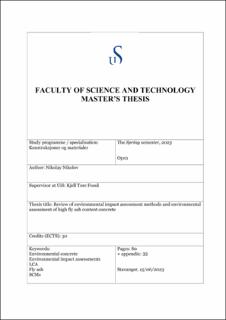| dc.description.abstract | The construction industry is one of the main sources of pollution in the world with concrete and cement production accounting for at least 8% of the global greenhouse gas emissions. The recent increase in demand for environmentally friendly materials and buildings has resulted in the development of new concretes with a reduced environmental footprint. Common practice is to replace part of the cement binder with supplementary cementitious materials which have pozzolanic properties of which fly ash, blast furnace slag and silica fume are the most common. Through the replacement of cement in the binder the concrete is able to directly reduce its total environmental impact.
The rise of environmentally friendly solutions has led to an increase of eco labeling, comparative assertions, and misleading claims regarding their performance. In order to ensure that such claims are accurate different assessment methodologies applicable for the European continental environment have been developed such as CML 2.1, Eco Indicator 99, ReCiPe 2016 among others. These methods all adhere to the ISO 14040 series of standards and by extension the CEN/TC 350 series (EN 15804 and EN 15978). The standards allow for comparison and transparency on how buildings and building materials are evaluated by providing core rules and regulations which have to be followed in order to gain a credible certification. The specifications provided for Environmental Product Declarations and building Life Cycle Assessments require the inclusion of mandatory environmental indicators in the form of global warming potential, acidification potential, eutrophication potential, photochemical ozone creation potential, ozone depletion potential, adiabatic depletion potential of minerals and fossil fuels. These standardized indicators are based on scientifically backed and agreed upon calculation methods, this means that products, services, and buildings that have undergone an environmental evaluation in accordance with ISO/EN have a transparency, quality, reliability, and third-party verification guarantee. Further optional details and indicators can be included as needed through the use of one of the afore mentioned impact assessment methodologies.
A basic high fly ash content concrete was developed (50% fly ash) to be incorporated as part of a multi-story concrete parking garage in order to quantify how effective it is in reducing the environmental footprint of the building as a whole. The results indicated a total of 15,28% reduction in the parking garage’s greenhouse gas emissions. However, when considering the buildings energy usage throughout its 60-year design service life the reduction due to the environmentally friendly concrete alone was not enough to achieve a significant result. The use of supplementary cementitious materials such as fly ash prove effective at lowering the environmental footprint of concrete buildings but should be paired with other measures such as additional “green” materials and clean sources of energy to supply the building and processes such as transportation of materials and machinery needed for the construction. | |
